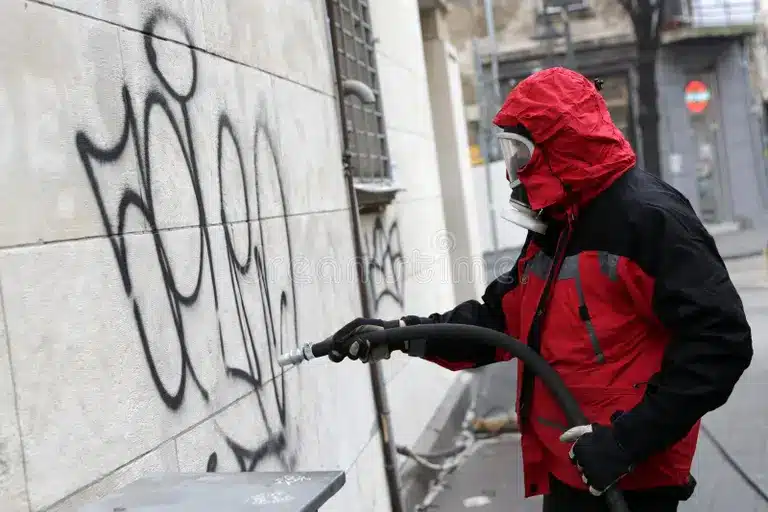- North York, ON
- Info@allseasonenterprise.com
- 416.829.0060
- North York, ON
- Info@allseasonenterprise.com
- 416.829.0060
Solutions from Experts to Remove Graffiti from Different Surfaces
Graffiti, though often considered a form of art by some, can be a real nuisance for property owners and communities. It not only defaces surfaces but can also lead to a sense of insecurity and lowered property values. Removing graffiti effectively requires a good understanding of the various techniques and products available for the job. In this blog, we will explore expert solutions for graffiti removal from different surfaces, shedding light on the best practices and the use of graffiti removers.

Understanding the Challenge: Graffiti Removal Techniques
Graffiti comes in various forms, ranging from spray paint to permanent markers, and it can be found on diverse surfaces such as brick walls, concrete, glass, and metal. The type of graffiti and the surface it is on greatly influence the removal technique you should employ. Let us dive into some expert-approved graffiti removal techniques.
1. Surface Type Matters:
Before you begin the graffiti removal process, you must identify the type of surface. Different surfaces react differently to graffiti removers, and using the wrong product can damage the surface irreparably. Here is a breakdown of common surface types and their corresponding removal methods:
- Brick Walls: Brick is porous, making graffiti removal challenging. Soft pressure washing with hot water and a mild detergent is a common technique. Afterward, a graffiti remover can be applied for stubborn stains.
- Concrete: Concrete surfaces are more forgiving, and pressure washing with a graffiti remover can be effective. Chemical graffiti removers are particularly useful on concrete.
- Glass: Razor blades and a glass-safe graffiti remover are the best options for removing graffiti from glass surfaces.
- Metal: Metal surfaces can be sensitive to certain chemicals. Graffiti removers designed for metals or sandblasting may be required.
2. Choosing the Right Graffiti Remover:
Selecting the appropriate graffiti remover is crucial for effective removal without causing damage. Here are some considerations:
- Environmentally Friendly Removers: Look for eco-friendly graffiti removers that are safe for both the environment and the user. These products often use biodegradable ingredients.
- Graffiti Type: The type of graffiti (spray paint, marker, etc.) will determine which remover is most effective. Check the product label for compatibility.
- Surface Compatibility: Ensure the graffiti remover is safe for the surface you are working on. Assess a small, inconspicuous area before full-scale removal.
- Safety Precautions: Always follow safety guidelines when using graffiti removers, including wearing protective gear such as gloves and goggles.
3. DIY Methods:
While there are professional services available for graffiti removal, some minor graffiti problems can be tackled using DIY methods. Here are a few effective techniques:
- Hot Water Pressure Washing: For smaller graffiti tags on surfaces like concrete and brick, a hot water pressure washer can work wonders. This method is environmentally friendly and does not require chemicals.
- Baking Soda Blasting: A mixture of baking soda and water can be used in a blasting machine to remove graffiti from various surfaces. It is a gentle and non-toxic method that is effective on many surfaces.
- Acetone or Nail Polish Remover: For smooth surfaces like glass or metal, acetone or nail polish remover can be used. Apply a small amount to a clean cloth and gently rub the graffiti away.
4. Professional Graffiti Removal Services:
For large or stubborn graffiti problems, it is often best to hire professional graffiti removal services. They have the experience, equipment, and knowledge to effectively remove graffiti without causing harm to the underlying surface. These services often use specialized graffiti removers and techniques, including sandblasting and chemical cleaning.
5. Preventative Measures:
Once you have successfully removed graffiti, it is essential to take preventative measures to deter vandals from targeting your property again:
- Anti-Graffiti Coatings: Applying anti-graffiti coatings to surfaces can make it difficult for graffiti to adhere. These coatings allow for easier graffiti removal in the future.
- Community Engagement: Engaging with the local community and neighborhood watch programs can create a sense of ownership and discourage graffiti vandals.
- Quick Removal: Promptly remove any new graffiti as soon as it appears. Vandals are less likely to return to a spot where their work is consistently removed.
6. Maintaining a Graffiti-Free Environment
Graffiti vandalism is an ongoing issue in many urban areas, and achieving a graffiti-free environment requires ongoing efforts. Here are some additional strategies and insights to help you maintain a clean and graffiti-free space:
- Community Involvement: Building a sense of community ownership is essential in preventing graffiti. Encourage residents, business owners, and local organizations to take pride in their neighborhood’s appearance. Organize community clean-up events to remove graffiti promptly.
- Surveillance and Lighting: Installing surveillance cameras and proper lighting in vulnerable areas can deter vandals. Vandals are less likely to target locations where they may be recorded, and well-lit areas provide fewer hiding spots.
- Rapid Response: Develop a rapid response system for graffiti removal. The longer graffiti remains visible, the more it can attract additional tagging. Implement a reporting mechanism for residents and business owners to notify authorities about new graffiti.
- Education and Awareness: Educate the community, especially young people, about the consequences of graffiti vandalism. Schools, community centers, and youth programs can play a role in raising awareness about the negative impacts of graffiti on neighborhoods and the potential legal consequences for vandals.
- Legal Consequences: Enforce strict penalties for graffiti vandalism to deter potential offenders. Knowing that graffiti can lead to fines, community service, or even jail time can discourage vandals from engaging in such activities.
- Public Art Initiatives: Promote public art initiatives that provide a creative outlet for artists. By offering designated spaces for street art, communities can channel artistic expression away from illegal tagging. Some cities have successfully implemented mural programs that transform dull walls into vibrant art installations.
- Graffiti-Resistant Materials: Consider using graffiti-resistant materials for surfaces that are frequently targeted, such as transit stations, public restrooms, and public transportation vehicles. These materials make graffiti removal easier and discourage vandals.
- Monitoring Trends: Stay informed about graffiti trends and patterns in your area. Monitoring graffiti styles and symbols can help authorities identify and track specific graffiti crews or individuals responsible for vandalism.
- Public-Private Partnerships: Forge partnerships between public and private entities to address graffiti issues collaboratively. By working together, local businesses, property owners, and government agencies can develop comprehensive anti-graffiti strategies.
- Reporting and Documentation: Maintain thorough records of graffiti incidents, including photographs, locations, and dates. This documentation can be valuable in tracking trends, identifying repeat offenders, and evaluating the effectiveness of graffiti prevention measures.
In conclusion, tackling graffiti vandalism is an ongoing process that requires a combination of preventive measures, community engagement, and prompt removal techniques. By implementing a holistic approach that combines expert graffiti removal techniques with community involvement, education, and deterrents, you can create an environment that is less attractive to vandals and ultimately maintain a graffiti-free space for everyone to enjoy. Graffiti may persist, but with the right strategies and collective effort, its impact can be minimized.
About Us
We look forward to being able to safely clean your home with advanced equipment that will bring your property back to life!
Washing Services
Contact Information
- All Season Enterprise
- 2645 Jane St, North York, ON M3L 2J3, Canada
- 416-829-0060
- Info@allseasonenterprise.com



